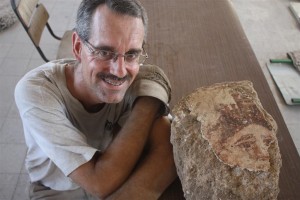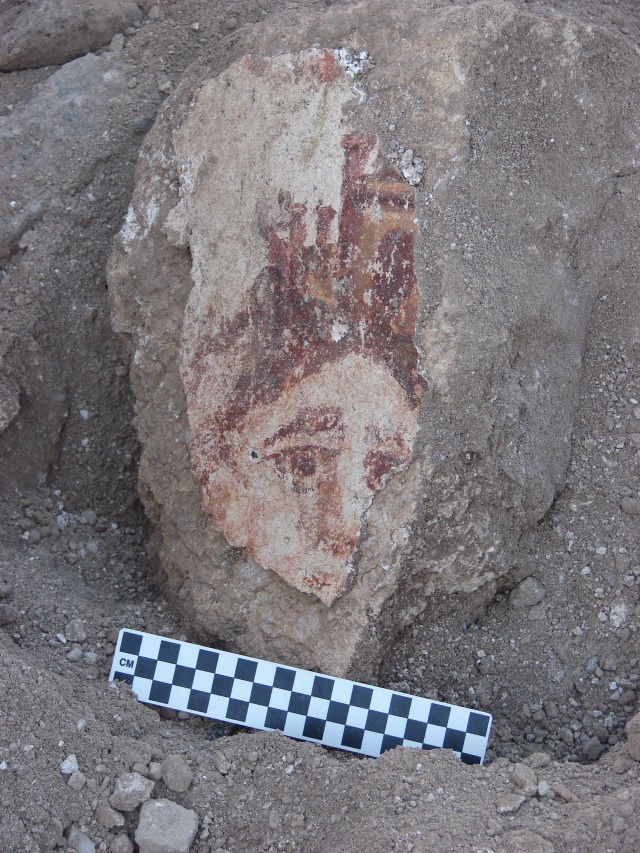“It’s a face!” Seminary professor uncovers ancient fresco
by Steve Chambers
It was my biggest shock of the summer. “It’s a face!” I cried, after turning over the stone. There she was, staring up at me just as an ancient artist had painted her on the plaster still clinging to this large limestone ashlar; a woman’s face, by no means complete but instantly recognizable—eyes, nose, part of her mouth, and—most significantly—a very curious crown on her head. The centuries fell away the instant I saw her and in their place, a new bond sprang up between me and the original inhabitants of this place.
Archaeologists dream of a find like this. Or at least I did, after spending part of three summers excavating a Byzantine church-complex at Hippos, Israel. Archaeology sounds terribly romantic, but to be honest a lot of the time it’s plain old hard work in the hot sun. Dirt, rock. More dirt, more rock. Bits of broken pottery. A shard or two of glass. A coin if you’re really lucky. But no matter how interesting the artefacts, they’re inert. They shed little glimmers of light on how this early Christian community lived and worshipped, but they’re still just stuff.
But then she popped to the surface, her eyes so vivid they grabbed and held my gaze. A person! I think she’s the most realistic representation of a human being anyone has found so far in the eleven years the city of Hippos has been under excavation. The word spread like wildfire, and people came running from every direction. Dr. Arthur Segal, the dig’s director, chattered away excitedly in Hebrew to his students from the University of Haifa. Dr. Mark Schuler of Concordia University-St. Paul, the head of our joint American-Canadian team, went straight to work documenting the find with dozens of photos. I stood there and grinned. What an awesome feeling!
So who was she? Her crown is a dead giveaway. Instead of points or jewels, it’s topped with the walls and towers of a city. That means her name is Tyche, the goddess of fortune who guarded the well-being of cities all over the Greco-Roman world. Researchers have found her portrait in mosaics and on coins at half a dozen ancient sites in Israel. Now we know she was honoured at Hippos too!
Why she adorned the wall of a ritzy mansion attached to a church is still an open question. But she seems to date from the 3rd or 4th century—at least a century older than the church. Maybe her portrait was so compelling that the Christians couldn’t bear to erase it. Maybe she no longer had much religious significance, but reminded people of an earlier era’s high culture. Or maybe she mostly served as kind of a civic mascot, the personification of Hippos’ hopes and dreams.
Big finds raise big questions. It’s going to be fun to figure out, in the next few years, how this elegant woman fits into the bigger story of the North-East Church and its neighbourhood.
Dr. Steve Chambers teaches at Concordia Lutheran Seminary, Edmonton. He has led three teams of students and volunteers from across Lutheran Church–Canada to the Hippos dig (2006, 2008, 2010), and plans to return to the North-East Church Project again in 2012.







